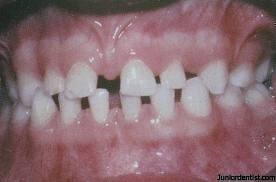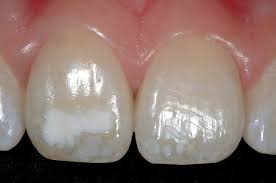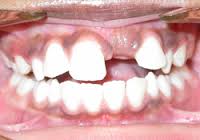Introduction
Diet and its nutritional consequences can have a profound influence on tooth development. Development of primary teeth begins when the foetus is between 6-8 weeks and is completed by the time the child is three years of age with the completion of the formation of the root’s structures of the tooth. With regard to permanent dentition, tooth development commences about 20 weeks in uterine and continues until adulthood with calcification of tooth structures of the permanent molars. Teeth are formed by mineralization of a protein matrix. The mineralization process begins as early as four months of gestation and continues into late adolescence as the root structures are completed. A pregnant woman’s nutrient intake must therefore supply the pre-eruptive teeth with the appropriate building materials. Severe nutrient deficiencies during pregnancy may result in oral malformations in the child and teeth that are more susceptible to dental caries.
Nutrient and its effect on tooth development
Nutrients essential for tooth development and maintenance include proteins, vitamins A, C and D as well as calcium and fluoride. The protein in dentin is collagen, which is dependent on vitamin C for normal synthesis. A tooth’s enamel contains keratin, a type of protein, and requires vitamin A for its formation. Vitamin D is essential to the process by which calcium and phosphorus are deposited into crystals of hydroxyapatite, the structural matrix of bones and teeth.
During tooth development, fluoride is incorporated into the pre-eruptive tooth’s mineralized structure, along with calcium and phosphorus to form fluorapatite, a compound more resistant to erosion than hydroxyapatite. After the tooth erupts, fluoride is no longer involved systemically in tooth formation. However, the topical effects of fluoride continue to impart protection against tooth decay by decreasing demineralization when the tooth is exposed to organic acids and by increasing the rate of remineralization following erosion by plaque acids.
Effect of nutrient imbalance on tooth development
Deficiencies of nutrients can have a wide range of effects on tooth development. Protein malnutrition can lead to delayed tooth eruption, reduced tooth size (microdontia) and decreased enamel solubility. In situations where calcium, phosphorus, and vitamin D are deficient, the hard structures of a tooth may be less mineralized; a condition termed hypomineralization. In addition, deficiencies of calcium, phosphorus and vitamin D can result in delayed eruption patterns of the dentition. A lack of vitamin A can cause a reduction in the amount of enamel formation or enamel hypoplasia. Fluoride deficiency causes increased demineralization when the tooth is exposed to an acidic environment, and also delays remineralization. Furthermore, an excess of fluoride while a tooth is in development can lead to a condition known as fluorosis.
 Microdontia |
|
 Hypomineralization |
 Fluorosis |
 Delayed eruption |
Dietary Guidelines
Dietary advice for individuals is based on the recommendations in the Malaysian Dietary Guidelines (MDG) 2010. Since food can provide most if not all the nutritional needs, the basic assumption is that nutrient needs should be met primarily through food consumption. The MDG contains certain key recommendations for nutritional intake for individuals.
For the purpose of tooth development, adequate intake of nutrients is of paramount importance. These include vitamins A, C, D, calcium, phosphorus, fluoride and protein.
Generally, the intake of these nutrients can be achieved by:
- Eating a variety of foods within the recommended intake
- Eating plenty of fruits and vegetables
- Consume moderate amounts of fish, meat, poultry, eggs, legumes and nuts
- Consume an adequate amount of milk and milk products
- Drinking plenty of water containing fluoride
Conclusion
Diet can have a significant effect on the process of tooth development and ultimately the health of the tooth. It is thus imperative that the individual or the expectant mother consumes a balanced dietary intake which includes all the necessary foods and nutrients to ensure that teeth are fully developed, healthy and with minimal defects.
References
- DePaola DP, Faine M, Palmer C. Nutrition in relation to dental medicine. In Shils M, Olson J, Shike M, Ross AC, eds.. Modern Nutrition in Health and Disease, 9th Ed. Baltimore, MD: Williams and Wilkins, 1999: 1099-1124
- Li Y, Navia JM, Bian J-Y. Prevalence and distribution of developmental enamel defects in primary dentition of Chinese children 3-5 years old. Community Dent Oral Epidemiol 1995; 23(2): 72-79
- Rugg-Gunn AJ, Al-Mohammadi SM, Butler TJ. Effects of fluoride level in drinking water, nutritional status, and socio-economic status on the prevalence of developmental defects of dental enamel in permanent teeth in Saudi 14 year old boys. Caries Res. 1997; 31:259-267
- Seow WK. Enamel hypoplasia in the primary dentition: a review. J Dent Child 1991; 58:441-452
- Nutrional Factors in Tooth Development and Maintenance: American Dental Hygienists’ Association (2012)
| Last Reviewed | : | 23 August 2019 |
| Writer | : | Dr. Leslie S. Geoffrey |
| Accreditor | : | Dr. Salleh b. Zakaria |
| Reviewer | : | Dr. Sharol Lail bin Sujak |







